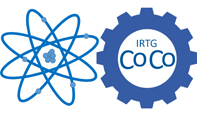07.07.2015 - Dr. Johannes Deiglmayr - Exotic chemistry with ultracold Rydberg atoms and molecules
| When |
Jul 07, 2015
from 04:00 PM to 05:00 PM |
|---|---|
| Where | HS II, Physik Hochhaus, Hermann-Herder-Str. 3 |
| Add event to calendar |
|
Atoms in Rydberg states of high principal quantum number n exhibit unusual physical properties such as large size, long lifetime, and high polarizability, leading to strong interatomic interactions. High-resolution spectroscopy of ultracold atomic samples allows us to investigate these interactions in detail and improve our understanding of the relevant couplings. In our experiments, ultracold cesium atoms are excited directly to Rydberg states in a one-photon excitation scheme. The first type of molecular states I shall discuss are Cs2 dimers, in which both atoms are excited to high Rydberg states. These dimers are called macrodimers and are observed in our experiments following Rydberg excitation with an intense, pulsed UV laser. The interactions between the two Rydberg atoms giving rise to these macrodimers are modeled using a long-range multipole expansion, with relevant contributions from terms up to the octupol-octupol contribution [1].
The second type of molecules are Cs2 molecules, in which one of the atoms is in a high Rydberg state and is bound to a ground-state atom located inside the orbit of the Rydberg electron. The binding mechanism does not fit into one of the known categories of bonds (covalent, ionic, metallic, or van der Waals) but results from the scattering of the slow Rydberg electron off the ground-state atom. Among the unusual properties of these molecules are huge bond lengths exceeding 1000 Bohr radii at n=30 and extremely low binding energies (typically much less than 1 GHz) [2].
These molecules nevertheless have sharp vibronic levels and high-resolution spectroscopy reveals all details of their structure and dynamics. If time permits I will also briefly present our approach to investigate cold ion-neutral reactions by studying the corresponding Rydberg-molecule–neutral reaction. To this end we have setup a merged-beam collision experiment for studying the H∗+H2→H++H+e− reaction at collisions energies down to 100 mK.
[1] J. Deiglmayr, H. Saßmannshausen, P. Pillet, and F. Merkt, Phys. Rev. Lett. 113, 193001 (2014).
[2] H. Saßmannshausen, F. Merkt, and J. Deiglmayr, Phys. Rev. Lett. 114, 133201 (2015).


